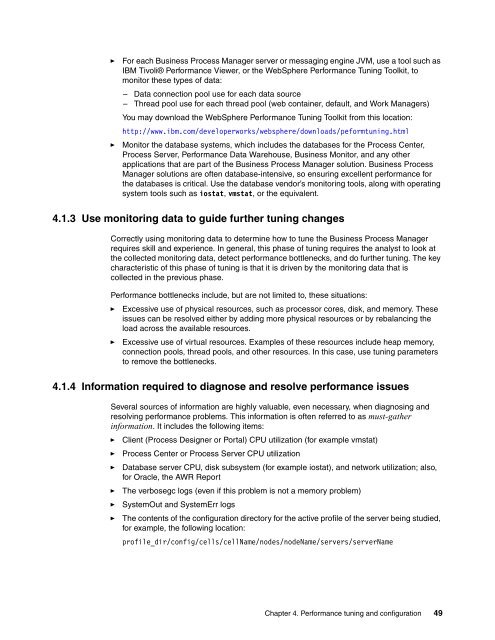Download PDF (1.3 MB) - IBM Redbooks
Download PDF (1.3 MB) - IBM Redbooks
Download PDF (1.3 MB) - IBM Redbooks
You also want an ePaper? Increase the reach of your titles
YUMPU automatically turns print PDFs into web optimized ePapers that Google loves.
►<br />
►<br />
For each Business Process Manager server or messaging engine JVM, use a tool such as<br />
<strong>IBM</strong> Tivoli® Performance Viewer, or the WebSphere Performance Tuning Toolkit, to<br />
monitor these types of data:<br />
– Data connection pool use for each data source<br />
– Thread pool use for each thread pool (web container, default, and Work Managers)<br />
You may download the WebSphere Performance Tuning Toolkit from this location:<br />
http://www.ibm.com/developerworks/websphere/downloads/peformtuning.html<br />
Monitor the database systems, which includes the databases for the Process Center,<br />
Process Server, Performance Data Warehouse, Business Monitor, and any other<br />
applications that are part of the Business Process Manager solution. Business Process<br />
Manager solutions are often database-intensive, so ensuring excellent performance for<br />
the databases is critical. Use the database vendor’s monitoring tools, along with operating<br />
system tools such as iostat, vmstat, or the equivalent.<br />
4.<strong>1.3</strong> Use monitoring data to guide further tuning changes<br />
Correctly using monitoring data to determine how to tune the Business Process Manager<br />
requires skill and experience. In general, this phase of tuning requires the analyst to look at<br />
the collected monitoring data, detect performance bottlenecks, and do further tuning. The key<br />
characteristic of this phase of tuning is that it is driven by the monitoring data that is<br />
collected in the previous phase.<br />
Performance bottlenecks include, but are not limited to, these situations:<br />
► Excessive use of physical resources, such as processor cores, disk, and memory. These<br />
issues can be resolved either by adding more physical resources or by rebalancing the<br />
load across the available resources.<br />
► Excessive use of virtual resources. Examples of these resources include heap memory,<br />
connection pools, thread pools, and other resources. In this case, use tuning parameters<br />
to remove the bottlenecks.<br />
4.1.4 Information required to diagnose and resolve performance issues<br />
Several sources of information are highly valuable, even necessary, when diagnosing and<br />
resolving performance problems. This information is often referred to as must-gather<br />
information. It includes the following items:<br />
► Client (Process Designer or Portal) CPU utilization (for example vmstat)<br />
► Process Center or Process Server CPU utilization<br />
►<br />
►<br />
►<br />
►<br />
Database server CPU, disk subsystem (for example iostat), and network utilization; also,<br />
for Oracle, the AWR Report<br />
The verbosegc logs (even if this problem is not a memory problem)<br />
SystemOut and SystemErr logs<br />
The contents of the configuration directory for the active profile of the server being studied,<br />
for example, the following location:<br />
profile_dir/config/cells/cellName/nodes/nodeName/servers/serverName<br />
Chapter 4. Performance tuning and configuration 49
















